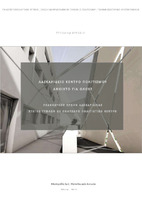| dc.contributor.advisor | Sinou, Maria | |
| dc.contributor.author | Μαστιχιάδη, Ζωή | |
| dc.contributor.author | Ρώτα, Γεωργία Αντωνία | |
| dc.date.accessioned | 2023-07-18T07:40:17Z | |
| dc.date.available | 2023-07-18T07:40:17Z | |
| dc.date.issued | 2023-07-04 | |
| dc.identifier.uri | https://polynoe.lib.uniwa.gr/xmlui/handle/11400/4701 | |
| dc.identifier.uri | http://dx.doi.org/10.26265/polynoe-4539 | |
| dc.description.abstract | Την σύγχρονη εποχή, στις αστικές κοινότητες, παρατηρείται πλήθος αχρησιμοποίητων και ερειπωμένων οικοδομημάτων, τα οποία δύναται να διαμορφωθούν αρχιτεκτονικά, με τέτοιο τρόπο ώστε να είναι πλήρως λειτουργικά, διατηρώντας τη πολιτιστική κληρονομιά της περιοχής και ανανεώνοντας αισθητικά τον περιβάλλοντα χώρο. Η λειτουργική χρήση τους, προσφέρει πολιτιστικά, οικονομικά, βιώσιμα και περιβαλλοντικά οφέλη στην κοινωνία. Ο πολιτισμός είναι μια από τις βασικότερες ανάγκες του ανθρώπου. Μέσω αυτού επικοινωνεί, μαθαίνει, δημιουργεί κι έρχεται σε επαφή με την υπόλοιπη κοινωνία. Η έννοια της πολιτιστικής κληρονομιάς περιλαμβάνει τα πολιτιστικά αγαθά, υλικά και άυλα, τα οποία συνθέτουν την έννοια του πολιτισμού και πρέπει να διατηρούνται ως σύνδεση του παρελθόντος και του μέλλοντος.
Η παρούσα πτυχιακή εργασία, μέσα από μια ανασκόπηση σχετικής βιβλιογραφίας και άλλων πηγών, πραγματεύεται την πρόταση επανάχρησης του Λασκαρίδειου Ιδρύματος στο Μαρούσι, ως Πολυχώρο Πολιτισμού. Κατά τη διάρκεια της έρευνας, για τον επανασχεδιασμό του κτηρίου, μελετήθηκαν οι όροι της επανάχρησης, των πολιτιστικών κέντρων και της πράσινης αυλής. Η εργασία χωρίζεται σε τρία βασικά κεφάλαια, τα οποία αποτελούν τη μελέτη που προηγήθηκε του σχεδιασμού, καθώς και την τελική πρόταση.
Βασικός στόχος του σχεδιασμού, είναι η διατήρηση της ιστορικής μνήμης του κτηρίου, η ανάδειξη του πολιτισμού στην περιοχή και η περιβαλλοντική ανάπτυξη του τόπου, μέσω του αειφορικού σχεδιασμού και της εφαρμογής των αρχών της πράσινης αυλής. Για την επίτευξη του στόχου, μελετήθηκαν οι παράμετροι του αειφορικού, βιοκλιματικού και παθητικού σχεδιασμού για την διαμόρφωση του κτηρίου και για το σχεδιασμό του περιβάλλοντα υπαίθριου χώρου, καθώς και τα μέσα με τα οποία εφαρμόζεται ορθή εκμετάλλευση και αξιοποίηση των φυσικών πόρων. | el |
| dc.format.extent | 132 | el |
| dc.language.iso | el | el |
| dc.publisher | Πανεπιστήμιο Δυτικής Αττικής | el |
| dc.rights | Αναφορά Δημιουργού - Μη Εμπορική Χρήση - Παρόμοια Διανομή 4.0 Διεθνές | * |
| dc.rights | Attribution-NonCommercial-NoDerivatives 4.0 Διεθνές | * |
| dc.rights.uri | http://creativecommons.org/licenses/by-nc-nd/4.0/ | * |
| dc.subject | Χώρος Πολιτισμού | el |
| dc.subject | Πολυχώρος | el |
| dc.subject | Κέντρο Πολιτισμού | el |
| dc.subject | Αειφορικός σχεδιασμός | el |
| dc.subject | Αειφορία | el |
| dc.subject | Πράσινη αυλή | el |
| dc.subject | Πολιτιστικό Κέντρο | el |
| dc.subject | Επανάχρηση | el |
| dc.subject | Εγκαταλελειμμένο κτήριο | el |
| dc.subject | Μαρούσι | el |
| dc.subject | Ειρήνη Λασκαρίδου | el |
| dc.subject | Λασκαρίδειος Στέγη | el |
| dc.subject | Λασκαρίδειο Ίδρυμα | el |
| dc.subject | Λασκαρίδειο Κέντρο Πολιτισμού | el |
| dc.subject | Πολιτισμός | el |
| dc.subject | Ήχος | el |
| dc.subject | Ρυθμός | el |
| dc.subject | Ένταση ήχου | el |
| dc.subject | Επανάληψη | el |
| dc.subject | Οπτικοποίηση ήχου | el |
| dc.subject | Χαράξεις | el |
| dc.subject | Ψυχαγωγία | el |
| dc.subject | Άτομα με Προβλήματα Όρασης | el |
| dc.subject | Επιμορφωτικές δραστηριότητες | el |
| dc.subject | Εξωστρεφής σχεδιασμός | el |
| dc.title | Λασκαρίδειο Κέντρο Πολιτισμού, ανοιχτό για όλους | el |
| dc.title.alternative | Laskaridios Cultural center, open to all | el |
| dc.type | Πτυχιακή εργασία | el |
| dc.contributor.committee | Sinou, Maria | |
| dc.contributor.committee | TOUSI, EVGENIA | |
| dc.contributor.committee | SKALKOU, KATERINA | |
| dc.contributor.faculty | Σχολή Εφαρμοσμένων Τεχνών & Πολιτισμού | el |
| dc.contributor.department | Τμήμα Εσωτερικής Αρχιτεκτονικής | el |
| dc.description.abstracttranslated | Nowadays, in urban communities, there are many unused, dilapidated or abandoned buildings, which can be architecturally designed in such a way that they can become fully functional, while preserving the cultural heritage of the area. Also, the design contributes to the aesthetic renewal of the surrounding area. Their functional use is highly beneficial, as it offers cultural, economic, sustainable and environmental benefits to society. Culture is one of the most important elements in humans’ life. Through culture, people can communicate, learn, create and connect with the rest of the society. The concept of cultural heritage includes the cultural goods and therefore they must be preserved as a link between the past and the future.
The present study, is divided into three main chapters. Through a review of relevant literature and other sources, the research concerns the definitions of cultural centers, sustainable building reuse and green yards, that influenced the design proposal. This current study, is about the reuse of “Laskaridios Foundation” in Maroussi city, as a Multi-Cultural Center.
The main purpose of the design is to preserve the historical memory of the building, highlight the culture in the area and the environmental development of the place, through the sustainability and the appliance of green yard’s principles. In order to achieve that, various parameters of sustainable, bioclimatic and passive design were studied, for the configuration of the building and the design of the surrounding outdoor space, as well as the means of the proper exploitation and utilization of natural resources. | el |


